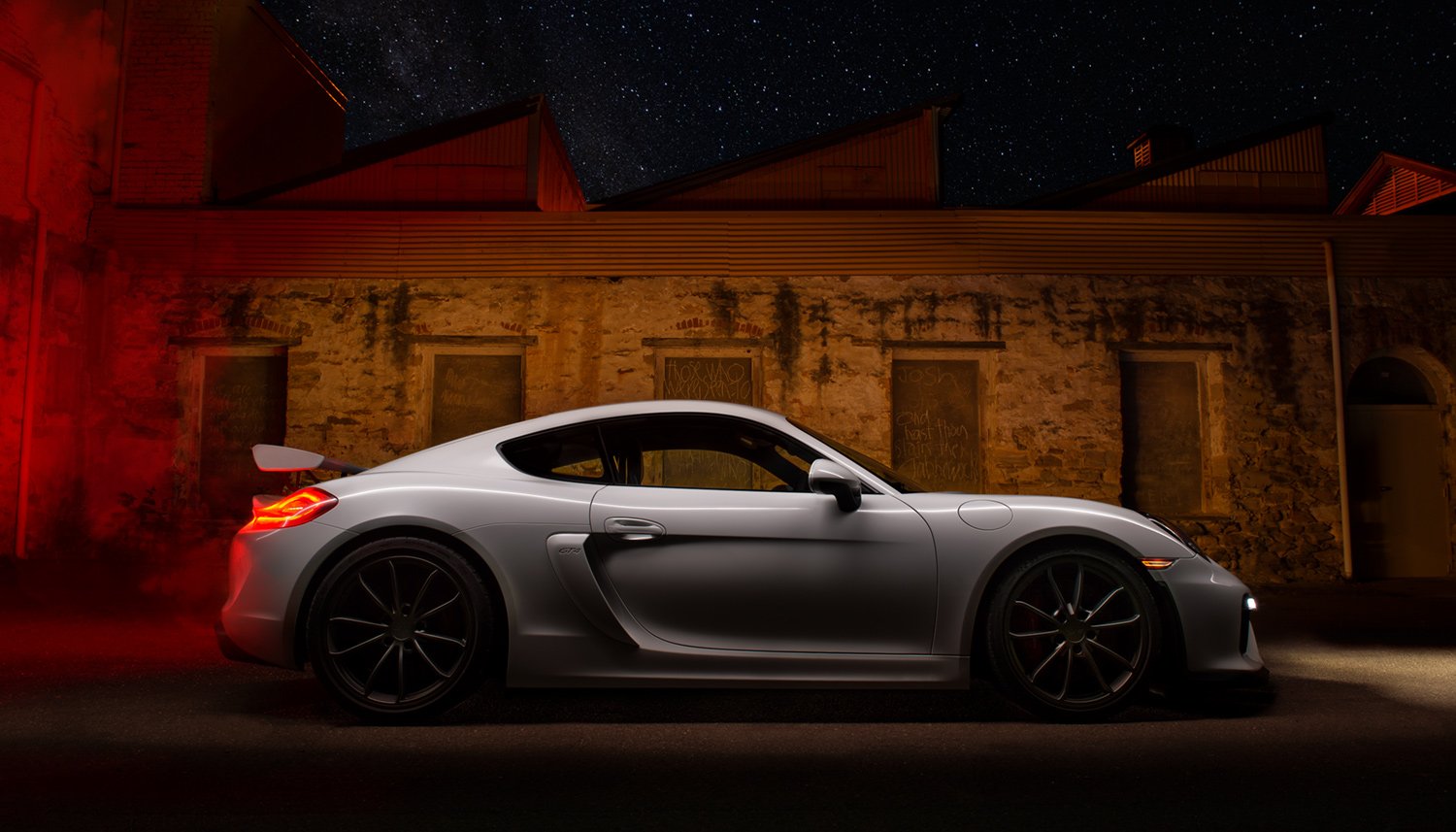Location Car Photography; Light Painting
Easter was particularly enjoyable this year, not only because of the chocolate, the remarkably good weather… and the chocolate but because it included shooting this stunning GT4 mid-engine Porsche. The owner had just completed the Adelaide Rally and was still buzzing from the experience which is not surprising given the staggering performance and sheer enjoyability of this car. Its mechanical grip is otherworldly and the acceleration is attention-grabbing. Bear in mind that this is the baby of Porsche’s GT series…
Pre-shoot, we scouted out a publicly accessible, rustic location in the Adelaide Hills. We ate well, dressed warm and set off on a cool clear night with the hope to get three images, a front three-quarter, a rear three-quarter and a side shot.
Photography of any vehicle is challenging, in fact, I can’t think of many objects which are harder to shoot. A car is a large object made up of a mixture of highly reflective complex curves with a combination of finishes that extend from mirror to matt, with potential colour ranges from gloss white to mat black.
I have been doing a lot of studio car photography with Finch Restorations In Mt Barker in the Adelaide Hills. A studio environment offers much greater control of reflections and lighting over outdoors. Though location automotive photography has a very different look, the checklist of desired outcomes is similar. Regardless of my approach, I want to place the car in an appropriate setting whilst showing off its strongest angles. I’m aiming to minimise reflections, give an accurate sense of the colour of the vehicle, show detail wherever possible and get a clean even slick that runs the length of the car. I want it to look dramatic and beautiful.
There are several ways to photograph a car on location. Available light, studio flash, light painting or a combination of any or all.
These photographs were created primarily by "light painting”. As the name suggests, I use a small portable light source and paint light across various sections of the car during a series of long exposures. With the car parked and the camera locked onto a tripod, I’ll make multiple exposures for specific areas of the car and background. The aim is to build up a group of photos with enough information in each of their specifically lit parts, to create a harmonious lighting event over the whole car. Then, using the best of those specific areas of each file, I’ll “build” a final image in post-production.
This is an additive form of lighting. Everything must start off very dark so I can have complete control of the quality of light, diffused or direct and where it goes. The Adelaide Hills has very little light pollution and we were on a quiet street so we didn’t suffer overly from intrusive headlights of passers-by.
Like much of the automotive photography I do, the final image is made from sections of multiple photos. The camera must remain locked in a fixed position on a tripod and ideally fired using a remote trigger. The smallest disturbance of the camera can put all of the images out of register.
For this shoot, I used an LED wand. The light was held static for the wheels, or I moved the light along the length of the car to create a long clean slick highlight that run down the entire body. To make this work I need to get a good exposure of every specific area of the image I will need in the final photograph.
Most of the photographs I made throughout this process have parts of me as a blurred vision and the light source is a floating line around the car. Remember, I can select particular parts of the image I need and discard the rest. If I keep moving, I disappear in the exposure of any well-lit sections. I am always sure to capture shots with the various light on. Headlights, interior lights and indicators, can be important if it’s a low-key night scene.
It’s an imprecise science as the physical distance of the light from the car, the angle and the time it lingers on any given panel will depend on the decisions and precision of the movements of the person wielding the light. Knowledge of the way light plays on reflective surfaces certainly helps too.
This method can yield stunning results but requires experience, huge attention to detail and a very methodical approach but with this level of control, it's possible to create any lighting event you can imagine.
Building up a seamless and believable-looking final photograph from fifteen or more separate files offers complete control but it's a considerable commitment of time.
Lucky for me I find it deeply satisfying.



